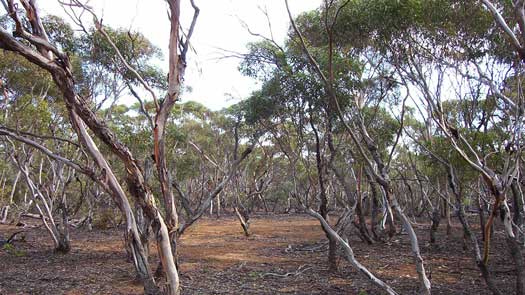Riverina
Key flora and fauna found along the middle Murray

The mallee eucalyptus woodlands of the plains of the Murray Darling Depression have adapted to be able to renew themselves after the summer droughts and fires that are common in the area. Along the major rivers, thicker Black Box (Eucalyptus largiflorens) and River Red Gum (E. camaldulensis) woodlands were once common on riverbanks.
Today, much of the original cover has been cleared for cropping and pasture. This is particularly evident in the lower Murray, where even the river red gums have been mostly cleared or replaced with willows.
The term 'mallee' refers to a growth form that is characteristic of multiple eucalypt species. These trees are small (3–10 metres high), highly drought-tolerant trees with large underground lignotuber ('mallee roots'). Multiple branches or trunks grow from these roots and terminate with clusters of branches with minimal foliage.
Common species include Eucalyptus costata, E. dumosa, E. gracilis, E. leptophylla, E. oleosa and E. socialis.
Other small trees and shrubs that are commonly associated with Mallee Woodlands include:
There are still some intact open forests along the river where it has not been choked with Willows (Salix babylonica). The dominant species is still the River Red-gum (Eucalyptus camaldulensis), albeit the understorey of Acacias that was seen upstream changes slightly to mostly Acacia dealbata, A. salicina or A. stenophylla.
Nearshore Australian Coastal Bioregion
The Coorong is a wetland of international importance, particularly as a habitat for migratory wading birds from across the world. The main lagoon is a low lying salt-marsh with towering sand dunes sheltering it from the predominant southerly winds.
While the barrages have significantly increased the health of the freshwater wetlands of Lake Alexandrina, the Coorong has suffered and become increasingly saline.
Over 350 plants have been recorded in the Coorong with nearly 250 of these being native. Some of species listed as rare include the White Correa (Correa alba), Star Spider-Orchid (Caladenia saxatilis), Swamp Honey-Myrtle (Melaleuca squamea), Pink Gum (Eucalyptus fasciculosa), Manila Grass (Zoysia matrella) and Velvet Daisy-Bush (Olearia pannosa ssp. cardiophylla).
A few of the other species are:
©2026 Alan Davison // Credit // Disclaimer